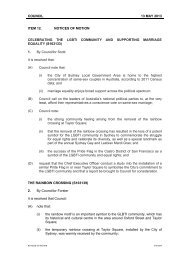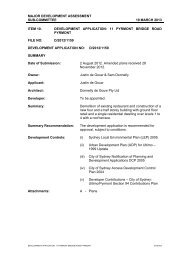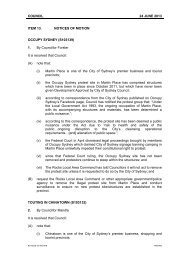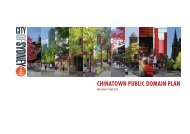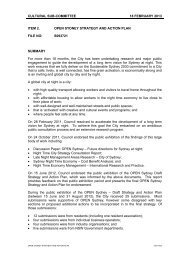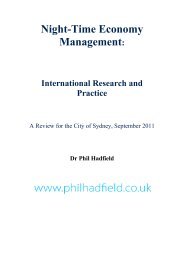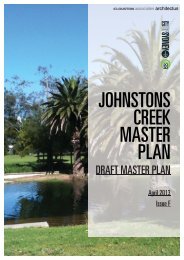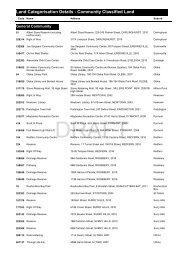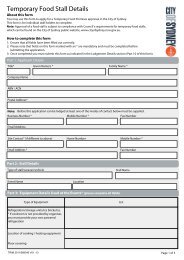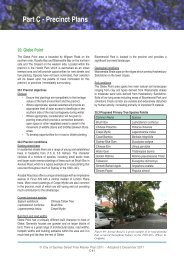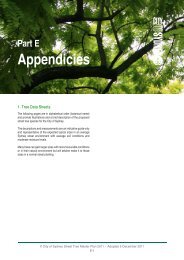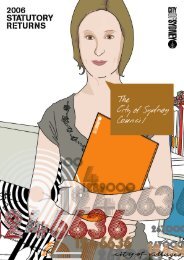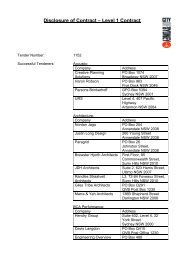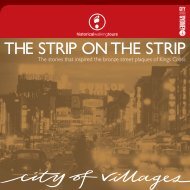Histories of Green Square - City of Sydney
Histories of Green Square - City of Sydney
Histories of Green Square - City of Sydney
Create successful ePaper yourself
Turn your PDF publications into a flip-book with our unique Google optimized e-Paper software.
<strong>Histories</strong> <strong>of</strong> <strong>Green</strong> <strong>Square</strong><br />
bred racing in part legitimised itself to middle-class critics<br />
by pointing out that it provided better quality horses for the<br />
agricultural sector and to the military. 13 This form <strong>of</strong> racing<br />
was therefore based around horses which showed pr<strong>of</strong>iciency<br />
in speed as well as endurance. Pony racing neglected these<br />
concerns in favour <strong>of</strong> the excitement and the ‘good betting<br />
races’ that sprint racing provided. We can see that pony racing<br />
was more concerned with presenting a spectacle than the Australian<br />
Jockey Club and other principal clubs. 14<br />
It is tempting to assume that proprietary racing was an inferior<br />
form <strong>of</strong> racing. However, proprietary racing had different goals<br />
from thoroughbred racing. It appealed to those who enjoyed<br />
tight finishes and a high number <strong>of</strong> chances, as opposed to<br />
the two-to-four-mile slogs occasionally raced at Randwick in<br />
which the winner was decided early in the race. 15 The idea that<br />
it was ‘inferior’ is more likely a result <strong>of</strong> the hierarchy <strong>of</strong> sports<br />
according to ‘worth’, constructed by middle class observers<br />
rather than working class participants.<br />
The Victoria Park Racing Club also followed its own conventions,<br />
suitable to its purposes. The best example <strong>of</strong> this is the<br />
disciplinary process that the club adopted. Stewards were<br />
employed by proprietary and non-proprietary racing clubs<br />
alike, to find and punish owners, jockeys and trainers who<br />
broke the rules. The stewards at Victoria Park had different<br />
practices, however. While the Australian Jockey Club procedure<br />
stated that the AJC stewards ‘must have before them all persons<br />
who are charged before hearing any evidence’, the stewards at<br />
Victoria Park heard testimony from all witnesses separately. 16<br />
As James Donohoe, stipendary steward at Victoria Park, stated<br />
before a 1923 Parliamentary Select Committee on the conduct<br />
and administration <strong>of</strong> pony racing: ‘If you call the [jockey] in<br />
and examine him first, he is likely to make statements contrary<br />
to the statements that the owner or trainer make’. 17 He claimed<br />
that interviewing separately was necessary in order to get the<br />
truth from those appearing before the stewards.<br />
This provides an important indication <strong>of</strong> the mentality <strong>of</strong> the<br />
racecourse administrators. The Victoria Park stewards were<br />
very keen to impose harsh penalties in order to protect the<br />
reputation <strong>of</strong> the sport. In fact, when asked whether the AJC<br />
system afforded the accused ‘a better chance’ by the committee,<br />
Donohoe’s sardonic reply was ‘Yes, <strong>of</strong> getting clear’. 18 There was<br />
clearly a recognition amongst <strong>of</strong>ficials that improper practices<br />
had to be stamped out in this code <strong>of</strong> racing, and they tried<br />
to divert attention away from themselves and onto cheating<br />
competitors.<br />
This was in part a response to the widely held perception<br />
among observers and competitors alike that the administration<br />
<strong>of</strong> proprietary racing was rife with corruption. Proprietary<br />
racing was <strong>of</strong>ten seen as an inferior sporting contest run<br />
by people <strong>of</strong> dubious character for purely financial reasons. It<br />
was alleged that the standard <strong>of</strong> the breeding <strong>of</strong> the horses was<br />
deliberately kept low for ‘no other purpose than to stimulate<br />
gambling’. 19 Pony racing therefore did not have the (so-called)<br />
nationalistic and economic justifications <strong>of</strong> thoroughbred<br />
racing. The courses were considered the ‘haunt <strong>of</strong> thieves’<br />
where dubious practices such as doping and rigging races<br />
took place, practices considered to be the result <strong>of</strong> low prizemoney.<br />
20 The races, it was argued, were run purely for pr<strong>of</strong>itmaking,<br />
and the small amount <strong>of</strong> prize-money put on <strong>of</strong>fer<br />
demonstrated this fact.<br />
Proprietary racing was usually run on weekdays as well as<br />
weekends. This meant that proprietary course attendance<br />
74<br />
rates were not affected by AJC meetings on Saturdays and<br />
public holidays. Here was more ammunition for the enemies<br />
<strong>of</strong> proprietary racing—their racetrack kept workers from<br />
their jobs and so pr<strong>of</strong>it was being placed above the prosperity<br />
<strong>of</strong> the nation. Workers were expected to work rather than<br />
enjoy recreation. This was the opinion <strong>of</strong> Joseph A. Wright,<br />
who appeared before the Select Committee <strong>of</strong> 1923 in his<br />
capacity as a representative <strong>of</strong> a league for the abolition <strong>of</strong><br />
proprietary racing. In his testimony, he also claimed that there<br />
was not an honest racing man alive, and that it was necessary<br />
to ‘stand in with the crooks’ to make a pr<strong>of</strong>it in the sport. Sir<br />
Joynton Smith himself, Wright asserted, was disqualified for<br />
life in New Zealand. This last claim was refuted on the basis <strong>of</strong><br />
Smith’s membership <strong>of</strong> the AJC. 21<br />
Accusations <strong>of</strong> unfair suspension <strong>of</strong> trainers and owners were<br />
also leveled against the <strong>of</strong>ficials <strong>of</strong> the Associated Racing Clubs.<br />
The stewards were alleged to have abused their power in order<br />
to pursue personal vendettas. Milton Richards, appearing<br />
before the committee, claimed to have been ‘forced out’ <strong>of</strong><br />
pony racing by <strong>of</strong>ficials. He also complained that <strong>of</strong>ficials<br />
required the owner or trainer <strong>of</strong> any good horse to inform<br />
them <strong>of</strong> the fact, in order to ‘cash in’ on the horse’s success. 22<br />
The Select Committee heard other complaints <strong>of</strong> this nature,<br />
including the case <strong>of</strong> Charles Edward Stephenson, the trainer<br />
<strong>of</strong> a horse named Queen Costella. The horse was expected<br />
to win a second division race at Victoria Park. However, as<br />
a result <strong>of</strong> scratchings, it was put in first division in a bad<br />
barrier and was outclassed. According to witness Frederick<br />
James Hodges, the <strong>of</strong>ficials (who apparently bet on the horse)<br />
were ‘very vexed and they threatened to have their revenge<br />
on the trainer on some future occasion’. Stephenson was later<br />
suspended for twelve months for ‘pulling’ his horse, which he<br />
claimed ‘ruined’ him. 23<br />
The treatment <strong>of</strong> the animals involved in the sport was considered<br />
by opponents <strong>of</strong> proprietary racing to be substandard.<br />
Doping (administering drugs to a horse) was said to be<br />
rife. The Select Committee heard the testimony <strong>of</strong> John Albert<br />
Bonser regarding the doping death <strong>of</strong> his horse Rosie Colour.<br />
The horse was found to have a large enough quantity <strong>of</strong> arsenic<br />
in its organs to kill it, but as it had died <strong>of</strong>f the racecourse, the<br />
stewards washed their hands <strong>of</strong>f the issue. However, the role<br />
<strong>of</strong> doping may have been overstated. James Douglas Stewart,<br />
prominent veterinarian, commented that doping had ‘practically<br />
played itself out. [Dopers] probably realise that it does<br />
not pay’. 24<br />
Horses in this period were put under greater stress than current<br />
racehorses. This can be seen in the case <strong>of</strong> Uncle Jim, a horse<br />
that ran on <strong>Sydney</strong>’s pony tracks just before the First World<br />
War. In the six and a half months between 11 th August, 1913<br />
and 28 th February, 1914, Uncle Jim ran in twenty-four races.<br />
He was run in races only four (or less) days apart on eight<br />
occasions between 3 rd January, 1914 and 28 th February, 1914. 25<br />
By comparison, the 2004 Golden Slipper winner Private Steer<br />
recently drew admiration for winning three races on three<br />
successive Saturdays. This enormous workload was tempered<br />
by the fact Uncle Jim usually competed in ‘Flying Handicap’<br />
sprint races. Other sporting contests, such as heavyweight<br />
boxing championships, were also held with greater regularity<br />
than they are today.<br />
There was obviously some degree <strong>of</strong> malpractice on the part<br />
<strong>of</strong> the <strong>of</strong>ficials and owners <strong>of</strong> proprietary racing. However, it<br />
would be naïve to suggest that other forms <strong>of</strong> racing were free<br />
<strong>of</strong> corruption or the influence <strong>of</strong> gambling on its <strong>of</strong>ficials. Even<br />
© Erik Nielsen<br />
Fig 9.4 Sam Hood ‘Two women collecting winnings’, 1935. Both men and women enjoyed betting on horseraces.<br />
(Source: Hood Collection, courtesy Mitchell Library, State Library <strong>of</strong> New South Wales.)<br />
the most prosperous owner in the colonial period needed to bet<br />
and win to keep their interest in the sport pr<strong>of</strong>itable. 26 Doping<br />
was also apparent in thoroughbred racing shortly after the end<br />
<strong>of</strong> proprietary racing in New South Wales. Tarien, winner <strong>of</strong><br />
the 1953 AJC Doncaster handicap and trained by T.J. Smith,<br />
was found to be doped. 27 Clearly malpractice could occur in<br />
even the most distinguished <strong>of</strong> races. Perhaps proprietary<br />
racing was unfairly condemned as its opponents were blinded<br />
by thoroughbred racing’s perceived status and respectability.<br />
Proprietary racing at Victoria Park was run to rules that<br />
generally, but not always, suited its patrons better than other<br />
forms <strong>of</strong> racing. Bettors were certainly favoured, while participants<br />
(human and equine) fared less well, although they were<br />
given opportunities to compete not afforded them elsewhere.<br />
9.5 Proprietary racing circuit: a site <strong>of</strong> class struggle<br />
The proprietary racing circuit developed around a relationship<br />
between mainly middle class proprietors and working<br />
class participants. Naturally, the interests <strong>of</strong> these two groups<br />
came into conflict, and it is interesting to observe how the<br />
participants reacted to these situations, as it illustrates the<br />
dynamics <strong>of</strong> popular culture. The relationship between the<br />
Association <strong>of</strong> Racing Clubs (ARC) (the proprietors) and the<br />
New South Wales Pony Owners, Trainers and Jockeys Association<br />
(OTJA) mirrors that <strong>of</strong> a relationship between employers<br />
and employees in a labour dispute. A major dispute developed<br />
in 1923 over the registration <strong>of</strong> two trainers by the ARC who<br />
were not members <strong>of</strong> the OTJA. 28 The OTJA displayed its discontent<br />
in two ways: a boycott on August 1923, and through<br />
testimony to the Select Committee <strong>of</strong> 1923.<br />
The August boycott was instigated when the OTJA announced<br />
that its members would not compete at the meeting at<br />
© Erik Nielsen<br />
Chapter 9 – A Course <strong>of</strong> Action<br />
Rosebery on Saturday 10 th August, holding their own meeting<br />
at Kembla Grange instead. As a result, only sixty entries were<br />
received for the Rosebery meeting, with a further twenty-two<br />
entries pulling out on the day. The boycotting trainers maintained<br />
a vigil that outnumbered the sparsely attended meeting<br />
at the sand hill overlooking the track, hooting and jeering<br />
riders and horses who competed. These horses were considered<br />
‘black’ in the same way that non-union labour is in an<br />
industrial dispute. 29<br />
The ARC had fired a pre-emptive strike against the jockeys at<br />
the Kensington meeting on the Wednesday. The jockeys were<br />
notified that failure to turn up to the Rosebery meeting would<br />
result in the cancellation <strong>of</strong> their registration, a sanction that<br />
was later carried out. 30 The ARC met on Monday, August 20 th<br />
1923 and further resolved to ‘decline to recognise or have any<br />
communication with the New South Wales Pony and Galloway<br />
Owners and Trainers Association’. 31 The ARC also allegedly<br />
mounted an intimidation campaign against bookmakers who<br />
worked at the Kembla Grange meeting. 32 We can see just how<br />
jealously the proprietors guarded their authority, and how<br />
jealously working people guarded their working conditions,<br />
right to organise and recreational activities.<br />
The Select Committee hearings <strong>of</strong> 1923–1924 were used as a<br />
sounding board by the OTJA to air their grievances against the<br />
ARC. The first witness, Thomas Dominic Kingsley, Secretary<br />
<strong>of</strong> the Association, used his testimony to express dissatisfaction<br />
with the proprietary arrangement <strong>of</strong> pony racing. One<br />
grievance was the lack <strong>of</strong> prize-money available to trainers and<br />
owners compared to their costs. The ARC was only contributing<br />
£875 per usual day <strong>of</strong> racing, to be divided amongst several<br />
races, an average stake being £60. The cost <strong>of</strong> running a horse<br />
75



